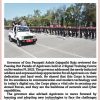Goa is abuzz with excitement as vintage bike and car owners, users, collectors and fans are decking […]

BACK FARMERS WHO ARE NATION’S BACKBONE!
Aug 21- Aug 27, 2021, In the News August 20, 2021PROTEST: Farmers protesting at Jantar Mantar with rats in their mouth, symbolizing how the country will suffer if their demands are not met.
By Tasneem Gazi
The Modi government must respond positively to the demands of farmers who have been on strike for almost a year now. It is only recently that they were permitted to demonstrate at Jantar Mantar.
FOOD, clothing and shelter are the basic necessities of life. If any one of these basic needs are not met human beings cannot survive. This is taught in every school. All food comes from plants or animals. It has to be grown reared or caught. Clothing? It has also to be grown or reared. Example, wool, cotton, etc. There are alternatives of synthetic fabrics but how comfortable are they?
The raw materials used by many industries come from farmers. For example, paddy straws for the brickmaking industry, raw materials for beverages — both soft and hard drinks industry. The minute we think about growing and rearing we get a clean picture of a farmer working on his fields. I do! Don’t you??
Farmers are the backbone of every society. A hundred times we might have come across the quote saying, “If you ate today, thank a farmer.” How do we thank a farmer? By mere words? This topic needs attention and I would start by writing my opinion from an Indian’s point of view. I have lived in Goa since birth. Even though I am not coming from a farmer’s family, I still desire to write about them and what they journey through life has been like to date.
COLONIAL EXPLOITATION
IT WOULD not be wrong to say that farming started in the middle period of the Stone Age, transiting from the early nomadic lifestyles into more settled lifestyles. Let us go back in time to see the life of farmers under British rule or pre-Independence times.
The search for the wealth and prosperity of India led to its colonisation by foreign powers. Take the two groups, British India and Portuguese India. The British had gained direct control over almost all of India, leaving Goa and a few other territories for the Portuguese. An Anglo-Portuguese treaty was also signed in 1878 for mutual understanding between these two colonial powers with the common interest of subjugating and enslaving the local people.
Britain got the credit for the construction of many canals, to allow more areas to be brought under cultivation. Farmers were in debt because they were forced to grow cash crops for which the input cost was high. They were not spared even during droughts and famines. In such situations they borrowed money from local money lenders at high interest and which trapped the farmers into a debt-ridden life lifelong. All these policies changed the traditional pattern of Indian agriculture, creating hatred for foreign rule which got manifested in the hearts of Indians and gave birth to rebellions and revolts of peasants and tribals.
The British have been ruthless with their exploitive schemes (reminding me of the Lagaam movie dialogue, “Tum saala ghulam log, humari jooti ke neeche hi rahega”). India has always been an agrarian country and the foreign colonialists took advantage of this fact to reap profits for themselves.
FIRST REVOLT
THE first revolt began in 1857. Revolution for freedom began and freedom fighters from all over India started planning secretly how to free the country from Briish tyranny and exploitation. Many freedom fighters sacrificed their lives in the big fight. It continued for decades and finally India was free in 1947.
What was our status post-independence? It is said that all good things come at a price. Indians were relieved from the clutches of Britishers. But Indian agriculture was in a bad state during on the eve of Independence. When India became independent in 1947, 90% of its population lived in 60,000 villages depending mainly on agriculture for their survival. The lack of proper technology and land reforms combined with droughts led India massive famine.
In the mid-1960s various steps were taken by the Indian government to improve the status of agriculture. One of these was called the Green Revolution. This was a period when agriculture in India transformed itself into an industrial system. Modern methods and technologies were used to yield high variety seeds, tractors, irrigation facilities, pesticides and fertilizers. The revolution commenced in 1966 and the slogan “Jai Jawan, Jai Kisan!” reverberates even today throughout the country.
GOVERNMENT SCHEMES
THE government then started many schemes to protect the crops against droughts, fires, floods and other calamities. Various co-operative banks and societies were established to provide farmers with loans at low rates of interest. But as much as the green revolution helped agriculture, there was the negative impact on a fragile agro-ecosystem. Loss of soil fertility, erosion of soil, soil toxicity, diminishing water resources, pollution of underground water, increased occurrence of human and livestock diseases, not to speak of global warming.
Indiscriminate and disproportionate use of chemicals polluted the soil, air and water and feed and fodder offered to livestock. This made farmers even more miserable due to the increased expenditure spent on cultivation. This gave rise to a lot of issues and challenges. The farmers were indebted since whatever they grew, they were paid a low price, they needed to spend whatever they earned to buy machinery needed for farming, plus pay the high interest loans from moocher moneylenders.
The farmers started working in extremely bad weather conditions for no extra cost and with failed irrigation methods, most farmers still rely await for the monsoon rain to do farming. Revolution never reached areas like Maharashtra and the southern states of India. That is why the highest number of suicide cases are reported from Maharashtra and Andhra Pradesh.
Let us come to the topic of suicides. Every year 1.5 lakh people commit suicide, out of which 90,000 are farmers. Every year! Farmers are the toughest people. If they are driven to suicide due to farming related reasons, than just imagine the situation they go through before they commit suicide. This reminds me of a commercial where a nine-year old girl hides ropes from her father who is a farmer, fearing that he might commit suicide, stalking her father all the time instead of going to school.
Millions of families across India live in fear due to unforeseen weather conditions. Young people have a tough time escaping such problems and poverty. Young unemployed people from states like Uttar Pradesh and Bihar migrate out of their state looking for alternative resources. Farmers are quitting farming and joining non-farming jobs. Reason? Earn more, with less efforts. The income of a farmer is around one-fifth compared to a non-farmer. Is farming on the verge of extinct in India?
WHAT IS DEVELOPMENT?
Today’s statesmen think buildings, tall skyscrapers, and tallest statues in villages…is development! What will farmers do in fancy, glass clad, luxurious buildings? For a farmer a successful harvest is real development. A roof over the head and roti on his home table is more than enough, and of course a debt free life.
The government has come up with farm bills, which they claim will free farmers from financial exploitation and mental harassment in the markets. Really?
Indian farmers have the ability to survive in the harshest seasons, climate change and often harsh destruction by wild fires, droughts and floods, also losing their family members in suicides. Yet they still stick to their occupation of farming whatever land they own or has been leased out. But thousands of farmers nowadays are thronging the streets protesting against what are perceived as the government’s anti-farmer farm bills. What you think is bothering them?
They refuse to quit farming even though they’re today facing the worst challenges on the streets protesting, leaving women and children behind at home to work on the fields. Many have lost their life in the protest against the latest government bills. Imagine farmers giving up on this protests and coming up with a new slogan on a placard saying, “Grow your own food!”
This is no less than a nightmare. The farmers need to be paid both for the increased cost of growing food and for the increased risk of loss of crops. It is time we talked about the real cost of our food, about how to rescue our farmers who grow the food we eat to say alive. It is time to raise the question: Why are farmers protesting? Don’t let them down, reach out to them with honest support and sincere wishes!
(The author Tasneem Gazi is based in Sarvordem.)















